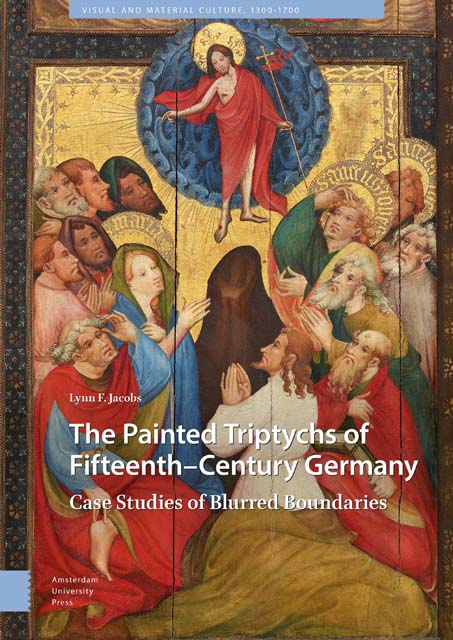Book contents
- Frontmatter
- Dedication
- Table of Contents
- List of Illustrations
- Acknowledgements
- Introduction
- 1 Framed Boundaries: Conrad von Soest and Early Fifteenth-Century Westphalian Triptychs
- 2 Transparent Boundaries: Colour on the Exterior of German Fifteenth-Century Triptychs
- 3 Regional Boundaries : Rogier van der Weyden’s Columba Altarpiece and Cross-Influences Between the Netherlands and Cologne
- 4 Spiritual Boundaries : The Master of the St. Bartholomew Altarpiece and the Border between Reality and Eternity
- 5 Coda: The Triptych in the Age of Dürer
- Bibliography
- Index
2 - Transparent Boundaries: Colour on the Exterior of German Fifteenth-Century Triptychs
Published online by Cambridge University Press: 16 November 2022
- Frontmatter
- Dedication
- Table of Contents
- List of Illustrations
- Acknowledgements
- Introduction
- 1 Framed Boundaries: Conrad von Soest and Early Fifteenth-Century Westphalian Triptychs
- 2 Transparent Boundaries: Colour on the Exterior of German Fifteenth-Century Triptychs
- 3 Regional Boundaries : Rogier van der Weyden’s Columba Altarpiece and Cross-Influences Between the Netherlands and Cologne
- 4 Spiritual Boundaries : The Master of the St. Bartholomew Altarpiece and the Border between Reality and Eternity
- 5 Coda: The Triptych in the Age of Dürer
- Bibliography
- Index
Summary
Abstract
This chapter examines the use of colour on German triptych exteriors—and the development of pictorial, rather than pseudo-sculptural forms of monochrome—as demonstrations of independence from Netherlandish traditions of grisaille. The presence of colouring on most fifteenth-century German triptych exteriors indicates that here, contrasts at the boundary between exterior and interior were not essential to the format—nor, for that matter, was it essential to use the exterior for the conscious display of the mimetic power of painting to simulate sculpture. Instead, German triptychs used coloured exteriors to explore Medialität by creating transparency between the exterior and interior, that is, by establishing close connections between the two zones through formal integration, including through consistencies in colouring.
Keywords: grisaille, Gabriel Angler, paragone, transparency, pictorial monochrome
The Resurrection Triptych in Stuttgart by the anonymous South German artist, the Master of the Ehningen Altarpiece (Fig. 2.1), is a testament to the strong influence of Netherlandish traditions on triptychs within German-speaking regions. The coat of arms on the exterior of this triptych indicates that the work was commissioned by Countess Palatine Mechthild of Rottenburg am Neckar, who donated it to the church of St. Mary at Ehningen in 1476. Mechthild was known for her interest in Netherlandish- Burgundian culture. Indeed, this triptych shows such strong affinities with the art Dieric Bouts—in style, motifs, and even its technique of painting on canvas pasted on wood—that the work is generally considered to be a copy of a lost work by Bouts. The triptych's central panel is extremely close in particular to the Resurrection in The Hague, which is attributed to the workshop, or a follower of Dieric Bouts.
The exterior of the Master of the Ehningen Altarpiece's Resurrection Triptych (Fig. 2.2) depicts an Annunciation scene, one of the most common themes found on the exterior of Netherlandish triptychs. The Ehningen Altarpiece Annunciation scene is very similar to an Annunciation in Richmond, Virginia (Fig. 2.3), which has been associated with the Dieric Bouts workshop or a Bouts follower. In the Stuttgart and Richmond Annunciations, the pose and garb of the angel, as well as the pose of the Virgin are all quite close; in addition, both works include a set of shelves in the background, and even have a scroll protruding in front of the second shelf.
- Type
- Chapter
- Information
- The Painted Triptychs of Fifteenth-Century GermanyCase Studies of Blurred Boundaries, pp. 93 - 164Publisher: Amsterdam University PressPrint publication year: 2022



